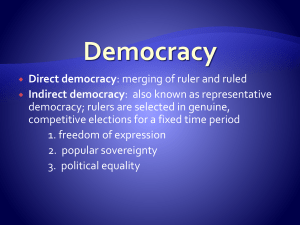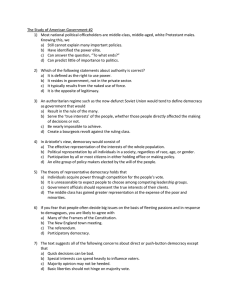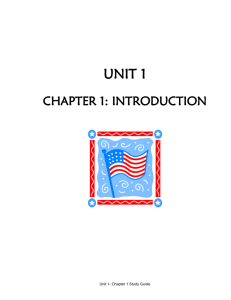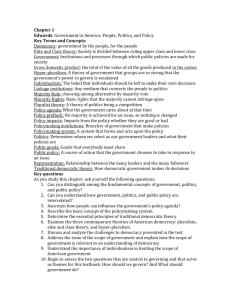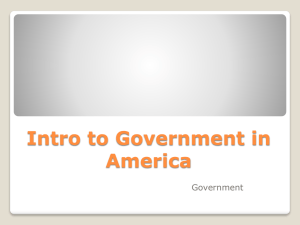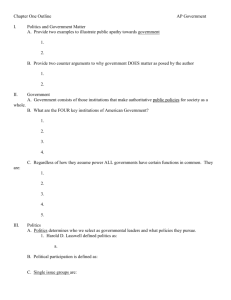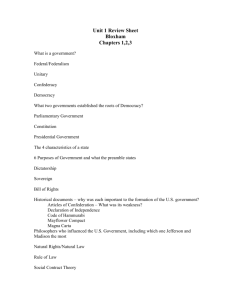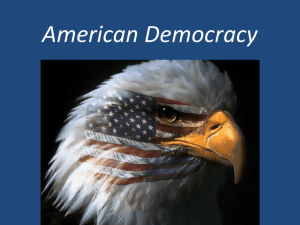Introduction to AP Government
advertisement
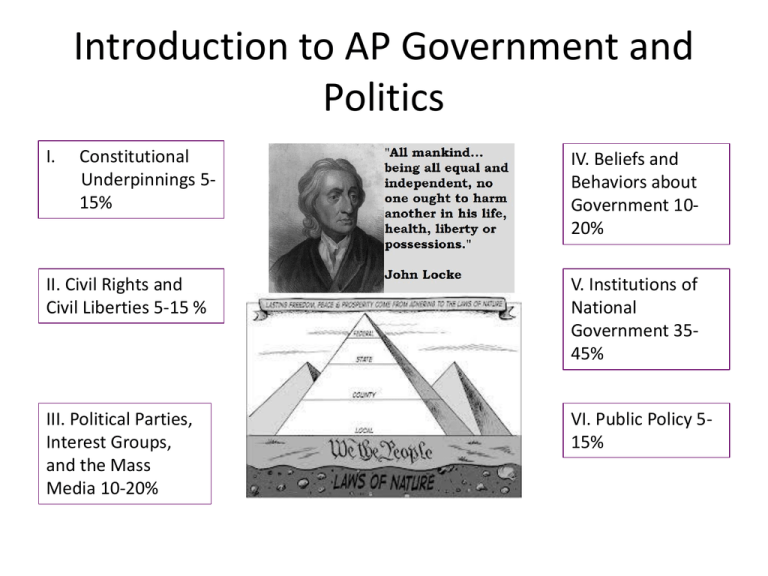
Introduction to AP Government and Politics I. Constitutional Underpinnings 515% IV. Beliefs and Behaviors about Government 1020% II. Civil Rights and Civil Liberties 5-15 % V. Institutions of National Government 3545% III. Political Parties, Interest Groups, and the Mass Media 10-20% VI. Public Policy 515% APGOPO TEST • 60 multiple choice questions in 45 minutes • 4 free response questions 100 minutes I. Constitutional Underpinnings 5-15% II. Civil Rights and Civil Liberties 5-15 % III. Political Parties, Interest Groups, and the Mass Media 1020% IV. Beliefs and Behaviors about Government 10-20% V. Institutions of National Government 35-45% VI. Public Policy 5-15% Super duper important information • If you choose to NOT take the AP government test in May, the highest grade you can get in this class is a C. • Attendance in this class is highly important, even though it is 6th period. If you are here on a day where you will miss sixth period for an activity, it is expected that you will still turn in your assignment if you were at school for any portion of the day. • Read the book nightly and check your syllabus—when you get it.. • You are responsible for approximately 1 chapter in your textbook per week. Governments around the world. You’d be amazed….. • At how much government shapes our lives. • Its…EVERYWHERE!!!!!!!!!!!!!!!! But how many governments are in America? 89,527 Wait….What???? That’s right. 89,527 This is called: • FEDERALISM • Examples? But back to Starbucks…. • Is it such a bad thing that we have so much government? That it is as ubiquitous as Starbucks? • This question is a Scope of Government question. We have always had this conversation in America. How much should the government do? Scope of Government how big is too big? Words we’ve all heard but let’s clarify: • Government-the institutions that make decisions for a society (for the US national government these institutions are Congress, The president, the courts and the federal administrative agencies AKA the Bureaucracy) Take a guess…..How many elected officials are there in the USA? Hint.. Not just nationally…. Lots! What would Thomas Jefferson Say? Most people agree that National governments should provide: 1. National Defense -USA spends 650 billion dollars on this! 2. Public services -schools, libraries, hospitals Public goods vs. public service Public goods cannot be denied to anyone, just by their nature e.g. access to highways….national defense Functions of Government • Preserve order! • Socialize the young….muah ha ha! • Collect taxes Politics • Politics-the process by which we select our governmental leaders and what policies these leaders pursue. • Most famous definition—Harold D. Lasswell’s “Who gets what, when, and how.” Policy making system -It always begins with the people. In my very humble opinion—(LMc.) This is what makes us great. You want to change something? It starts with YOU! Where else can that happen? Table 1.1 • Homework • Quiz tomorrow on table 1.1. types of public polices. Policy making institutions: • 1. Congress • 2. presidency • 3. courts The three that are established by the Constitution • Some political science brainiacs thing that bureaucracy is another institution Political participation • Voter turnout—usually low at mid-term elections in USA • Interest groups• Linkage institutions-parties, elections, interest groups and the media— the political channels by which people’s concerns become political issues on the policy agenda. The Policymaking System • The process by which policy comes into being and evolves over time. Figure 1.4 Figure 1.3 Democracy---the best! • Definition: – A system of selecting policymakers and of organizing government so that policy represents and responds to the public’s preferences. 1. Equality in voting—one person, one vote 2. Effective participation 3. Enlightened understanding— free ideas, free speech, 4. Citizen control of the agenda—if particular groups have control…a democracy ain’t happening! 5.Inclusion—citizenship open to all Founding Fathers did NOT agree Theories of U.S. Democracy • Pluralist Theory – A theory of government and policies emphasizing that politics is mainly a competition among groups, each one pressing for its own preferred policies. • Groups will work together. AARP and NRA and NOW, UAW are interest groups that will eventually find a way to represent their interest • Public interest will prevail! A positive view in general. Theories of U.S. Democracy • Elite and Class Theory – A theory of government and politics contending that societies are divided along class lines and that an upper-class elite will rule, regardless of the formal niceties of governmental organization. • Not all groups are equal • Policies benefit those with money / power. Corporate groups rule America, just like everywhere else. Theories of U.S. Democracy • Hyperpluralism – A theory of government and politics contending that groups are so strong that government is weakened. • There are too many ways for groups to control policy. • Confusing / contradictory policies. Too many groups participating Challenges to Democracy (sometimes, challenges are a good thing) 1. Is it too slow—so much policy equals policy gridlock 2. Who are the elite? Used to be: Those with land or money: e.g. Roosevelts, Kennedys 3. Now is it those with knowledge? Will this limit changes in participation? 4. Escalating costs to run a campaign. Mucho dinero Next week….American Culture and democracy • Read pp18-25 over the week end. Another way to look at federalism
